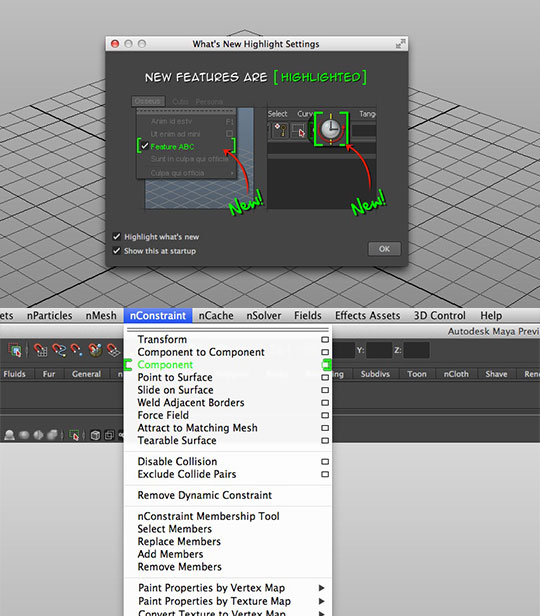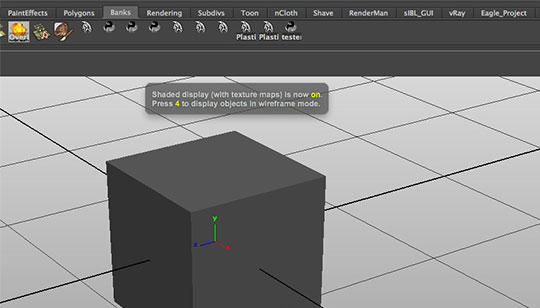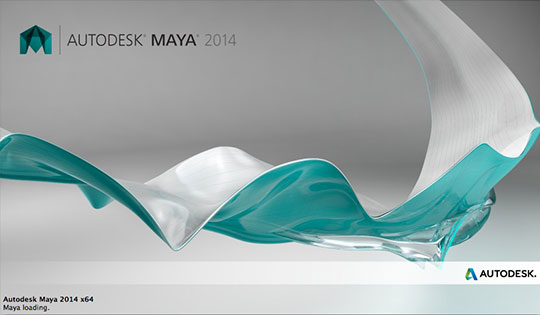Maya 2014, Some New Life, and Some Good Stuff
A while back Autodesk created “small annoying things” as a platform to provide a voice to users of Max, Maya, and Softimage, and the result could not have been better, not only did they listen, but they fixed. Today Autodesk Announced the Autodesk Creation applications for 2014, and here we will focus on the Maya 2014 release which hosts a HUGE set of new features and improvements.
OVERVIEW
Maya 2014 includes new Features to Modeling, including the Modeling Toolkit, a new Crease Set Editor, Polygon Reduction Tool Improvements, and new Edge Flow Tools. Maya 2014 also has a new a built in Grease Pencil Tool, New Features Highlighting System, a new viewport messaging system, additions to Paint Effects, Retiming and Non Linear Animation Improvements, a new Component nConstraint, some new redesigned nDynamics Icons, new features added to Viewport 2, and Mental Ray Unified Sampling, as a short list.
One of the things that you will notice immediately, is that Autodesk has changed the entire branding look and feel for not only Maya, but all their 3D Applications, right down to the splash screens, Desktop Icons, that is a following of the new company branding that is also throughout the User Guides and other materials. This is a welcome change from the “dragon” like imagery that was in use for the last little while and suggests visually, something new.
Autodesk has really taken the reigns on this one and put forth an absolutely astounding release for Maya 2014, having even added many new features and improvements to modeling. Yes this is not a mistake…modeling. This is one of the things tackled from the ongoing Maya Small Annoying Things initiative.
One of biggest and most exciting news is that Autodesk has purchased and incorporated the NEX modeling tools into Maya, which fills a hole in the rapidly antiquated Maya modeling toolset. This is more than a quick fix for the Maya development team as they did not simply slap on NEX and give it a new coat of paint and ship it out the door. They have made every effort to incorporate the NEX modeling toolset into Maya, and have added new features and improvements to NEX to it which is promising not only for this release but for other releases in the future.
SOME GREAT AND MUCH NEEDED ADDITIONS TO MODELING
Modeling Toolkit also known as NEX tools
Maya has long been in need of modeling updates, with applications around such as modo, or even Silo that make the Maya modeling toolset feel dated with some of the simplest tasks being obsolete, or even not working; An example would be the process of something as simple as a beveled edge, or splitting a polygonal face. In Maya 2014 Autodesk has incorporated the NEX modeling tools as the new Maya Modeling toolkit, and has given it some spiffy new icons, as well as some up-to-date fixes and integration into the maya workspace.
If you have used NEX in the past, then you are familiar with some of the offerings that NEX presents for modeling. If you have never used NEX before, you are in for some great features.
Edge Flow The Way It Should Be
Another great modeling improvement to Maya 2014, now includes a Edit Edge Flow tool which will let you split or cut faces in a row, and “keep” the intended surface form, respecting the curvature of the surrounding mesh faces. This Edge Flow paradigm has also been added as an option in all the split/cut tools, including the standard Insert Edge Loop Tool, the Interactive Split Tool, The Offset Edge Loop Tool, and the Connect Components tool.
A New Spin on the Old Polygon Reduction
The polygon reducing tools in Maya have been seemingly neglected, as is shown by the popularity of such programs as Atangeo Balancer. However now in Maya 2014, the Polygon Reduction tools have been updated with a new algorithm for reducing the number of faces while still keeping the object’s shape in tact. Using Polygon Reduction now will give you much more control and options for reducing the number of faces in a mesh including an option to keep existing lines, reducing by vertex count, triangle count or by percentage, and even export an index vertex map.
An Editor for Creases and Creases in Their Place
With the new Crease Set Editor in Maya 2014, you are now able to create and edit crease settings providing the ability to quickly group and adjust and use the hardness of creased edges, all within a single dock-able window.
Some other additions to the modeling environment in Maya 2014 include:
- Slide Brush
- Preserve Normals
- Vertex Color Visibility
- Displaying Hard Edges in Custom Colors
- Normals Size Editor Improvements
- Select Similar Polygon Components
- New Vertex Normal Method Preference
- Multi Component Selection
SOME NEW GREAT STUFF, ALL OVER THE APPLICATION
Maya shows You the New With the What’s New Highlight
One you open Maya, you are presented with a what’s new highlight dialog which will show all the new features in a bright green color. From here you are able to turn the dialog off, or change the green highlight as on or off. On will show all the new menus, icons, buttons as a bright green indicating what is new for Maya 2014.

ViewPort Messaging, Better than Before?
Maya 2014 has incorporated a new in-viewport messaging system that displays and passes messages at the top of the viewport for things like display mode selections, and the like. There are also settings for changing the duration, how it comes on, or even if it comes on at all for those that might find it annoying.

ToolClips, ToolTips But Better
A new ToolClips feature has been added to Maya, which essentially is an “expanded” tool tips which can have more information about a tool including a short video description on its use.
File Path Editor
You are now able to manage file paths with Maya 2014 with the new File Path Editor. This will list path information for your files, including referenced files, and even displays a resolving status icon, indicating file path issues. You are able to resolve path issues quite easily from here, using the RePath window, or using the replacement string tool. This will allow you to search and replace elements selected in the browser window.
Ignore Version global preference
Ignore version is now a global preference allowing you to check it once and always be able to load Maya files regardless of version number.
Improved navigation in the Outliner
The trusted Outliner now supports middle mouse click and drag to move the contents of the outliner left or right which is useful when working with larger hierarchies, as you don’t have to use the scroll bar at the window’s bottom to move left or right.
Attribute Editor improvements
The Attribute Editor in Maya 2014 now has the ability to never show notes. The Attribute Editor Notes field has moved from being a useful tool to the bane of many people over the last couple of releases, not remembering positional and size changes in the Attribute Editor… well now you can just axe the whole thing.
Convert geometry to bounding boxes
Maya 2014 has a new addition to convert selected geometry to bounding boxes which can be useful for reducing the level of detail needed in polygon and asset heavy scenes, and is a great method to create low res representations of objects in Maya Scene Assembly Workflows.
GPU caching improvements
There is a new addition to the GPU Cache Configuration preferences with will allow for optimization for how your particular graphics card will processes Alembic GPU Cache Files, allowing you to specify video RAM usage for caches and choose between OpenGL selection modes.
Larger Maya scene files and geometry caches
Maya now stores 64-bit indices in the Maya Binary file format, which will ultimately allow you to have more data in scene files and geo caches, which can now exceed 2.0 GB. This is facilitated through a new mcx file format which can take advantage of the larger cache file sizes, and it is worthy to note that scenes that are saved as the Maya Binary Format in 2014, are not downwardly compatible with previous versions of maya obviously.
Add metadata to Maya nodes
Maya now sports a new MetaData API which will let you create metadata structures that can be attached directly to mesh object components in Maya, including vertices, edges, faces, and even directly in a Node, by means of a small set of MEL commands.
New Node Editor improvements
There are a ton of Node Editor improvements in Maya 2014, foremost allowing you to view Maya Assets in the Node Editor, which will let you create connections to and from published attributes, and display details on the connections on a mouse hover. The look and feel of the Node editor has been greatly improved, now displaying Node Names in a box above the node making it much easier to read longer node names. A grid has been made available as a background for the Node Editor, and you can adjust the grid values, and colors to your liking. Tow other important additions are that you are now able to change the node editor view mode by using the 1,2,3 hotkeys, and you have the ability to set all newly created nodes as “pinned” by default.
Some of the other additions include:
- Include scene file name with CER report
- Preventing model panel window from stealing focus
- Incremental saving
- Cycle through cameras
- Create a new camera from the current view
- Default renderer and Viewport 2.0 render joints, cameras, lights and image planes as wireframe in bounding box mode
- Thick lines are now supported
- Multi-language support for 1-Minute Startup Movies
- Paint custom attributes
- New editor layout improvements
- Attribute Spread Sheet improvements
- New options added to shelf pull-down menu
- Hypergraph connection display
- New orthographic cameras added to Panels menu
- New free image planes maintain aspect ratio attribute
- Displaying a free image plane through a specified camera
- Free image planes supported by mental ray
MAYA 2014 GETS A FEW NEW ADDITIONS TO ANIMATION
Grease Pencil Tool
Maya 2014 will now let you draw directly in the viewport, sporting a new Grease Pencil tool. You can activate the grease pencil canvas at any frame in the timeline. This is a welcome base addition to Maya, however it is not as robust as the Blue Pencil Sketchpad for Maya solution, but it is a great way to take notes, compose shots and draw action lines.
On The Subject of Non Linear Animation
You are now able to use multiple offset objects when matching clips with the Trax editor in Maya 2014, which is useful for matching poses for more complex characters.
Some Great Additions to Retiming
The ReTime tool that was added in Maya 2013 will now allow you to change the timing of your animation by placing retime markers which you are able to drag around making editing a snap.
CHARACTER
Joint Symmetry
You can now build symmetrical joints and joint chains using the new Joint Tool Symmetry Setting, which makes the creation of symmetrical skeletons easy. There is also an easy way to access the options of the Joint Tool through a marking menu by hitting control, shift, right click.
Auto Joint Center
Maya 2014 adds the ability to auto-Center joints using the new Snap to Projected Center, which is useful for creating character joints and joint chains, but also can be used with any object type on creation.
Bend deformer Curvature in degrees
Autodesk has updated the curvature attribute in the Non Linear Bend Deformer, now allowing you to enter a value in degrees instead of radians, because few people speak in radians.
Some other changes and additions to Character tools in Maya 2014 include:
- Limit spread of small weights
- Improved influence locking in the Paint Skin Weights Tool
- Add a HumanIK Control rig to an animation layer
PAINT EFFECTS GETS SOME LOVE
Surface Interaction
Paint Effects sees some updates in Maya 2014 with improved surface interactions with surface snap, surface attract and surface collide attributes. Both the Set Surface Snap and Surface Attract attributes will pull a paint effects stroke toward objects, while the surface collide attribute will make collisions possible between paint effect strokes and surface points.
Occupation Surface and Occupation Volume
You are now able to fill an object with paint effect strokes, much the same way you can fill a volume with nParticles. The new Occupation Surface and Occupation Volume attributes will allow you to create more realistic foliage.
Make Paint Effects Object Collide With Other Objects
You can now create collisions between paint effects strokes and geometry with Maya 2014’s Make Collide. This is going to be great for creating rain effects, footprints and a ton of other stuff.
Create More Realistic Foliage By Randomizing Leaf and Flower Sizes
Another addition into allowing you to create more realistic plants in Maya, Paint Effects will now allow you to randomize leaf and flower sized with the new Leaf Size and Flower Size Random Attribute.
Line Modifier Fill Object
You can now add geometry to line modifier shapes with the new Set Modifier Fill Object. Used in conjunction with the set modifier fill object, you can create irregular shaped line modifier bounds.
CLEANING UP nDYNAMICS
nHair, Keep The Nodes You Want
Maya 2014 now has a new Delete nHair feature, which will let you remove hair components without deleting other hair system nodes that are useful in the rigging process.
A New Component nConstraint
A new component constraint makes its way into nDynamics, which will allow you to create a constraint for an nCloth node or its selected components based on the selected mesh topology.
Extending Fluid Effects
Maya Fluid Effects gets a Fill Object Volume and Start Frame Emission Attributes. Fill Object Volume will extend the surface emission options by allowing you to emit fluid into the volume of a selected object, while the Start Frame Emission will let you set framers for emissions without setting keyframes for them.
Fresh, New, and Redesigned nDynamics Object Icons
It is now much easier to distinguish between nObjects, dynamic nodes, and nHair follicles with newly designed icons for nDynamic objects that show in the node editor or the outliner.
New Attraction Method for nCloth
The newly added Input Attract Method will improve performance on nCloth mesh simulations by letting you specify which vertices will participate in simulations.
JUST IN TIME FOR VIEWPORT AND RENDERING
Viewport 2 and X11
Maya 2014 now supports Direct X 11 in Viewport 2.0 for Windows 64-bit systems allowing you to run Viewport 2.0 in either DirectX 11 or OpenGL mode.
New mental ray unified sampling available
Coloring Vertices in Viewport 2.0
Painting vertex color sets is now supported in Viewport 2.0 along with coloring vertices based on influence color.
Transfer Maps Adds Supports Custom Hardware Shaders
Maya 2014 now supports the ability to bake a shaded output map from a source to target objects with hardware shaders derived from MPxHwShaderNode
Other Maya 2014 rendering improvements include:
- New Skip existing frames attribute in Render Settings window
- New substance textures
- Troubleshooting mental ray rendering
- New ZIPS compression method for EXR files added
- mental ray version 3.11
Wrapping it Up
Maya 2014 looks to be an absolutely solid release in terms of the number of features, fixes, usability and most importantly stability. For more information on the Autdoesk


Lillian
One area that Maya falls behind C4D in is text. Any text improvements? Any improvements for motion graphics at all?
lesterbanks
zero in the text dept unfortunately – as far as motion graphics goes, i think MASH nodes for Maya are the only thing cohesive in that area right now.